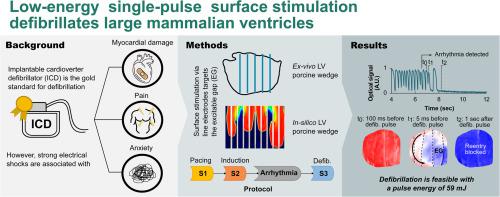Heart Rhythm ( IF 5.6 ) Pub Date : 2021-10-12 , DOI: 10.1016/j.hrthm.2021.10.006 Angel Moreno 1 , Richard D Walton 2 , Olivier Bernus 2 , Edward J Vigmond 1 , Jason D Bayer 1

|
Background
Strong electric shocks are the gold standard for ventricular defibrillation but are associated with pain and tissue damage. We hypothesized that targeting the excitable gap (EG) of reentry with low-energy surface stimulation is a less damaging and painless alternative for ventricular defibrillation.
Objective
The purpose of this study was to determine the conditions under which low-energy surface stimulation defibrillates large mammalian ventricles.
Methods
Low-energy surface stimulation was delivered with five electrodes that were 7 cm long and placed 1–2 cm apart on the endocardial and epicardial surfaces of perfused pig left ventricle (LV). Rapid pacing (>4 Hz) was used to induce reentry from a single electrode. A 2 ms defibrillation pulse ≤0.5 A was delivered from all electrodes with a varied time delay from the end of the induction protocol (0.1–5 seconds). Optical mapping was performed and arrhythmia dynamics analyzed. For mechanistic insight, simulations of the VF induction and defibrillation protocols were performed in silico with an LV model emulating the experimental conditions and electrodes placed 0.25–2 cm apart.
Results
In living LV, reentry was induced with varying complexity and dominant frequencies ranging between 3.5 to 6.2 Hz over 8 seconds postinitiation. Low-energy defibrillation was achieved with energy <60 mJ and electrode separations up to 2 cm for less complex arrhythmia. In simulations, defibrillation consistently occurred when stimulation captured >75% of the EG, which blocked reentry <2.9 mm in front of the leading reentrant wavefront.
Conclusion
Defibrillation with low-energy, single-pulse surface stimulation is feasible with energies below the human pain threshold (100 mJ). Optimal defibrillation occurs when arrhythmia complexity is minimal and electrodes capture >75% of the EG.
中文翻译:

低能量、单脉冲表面刺激对大型哺乳动物心室进行除颤
背景
强电击是心室除颤的金标准,但与疼痛和组织损伤有关。我们假设用低能量表面刺激针对折返的可兴奋间隙 (EG) 是一种破坏性较小且无痛的心室除颤替代方案。
客观的
本研究的目的是确定低能表面刺激对大型哺乳动物心室进行除颤的条件。
方法
用五个长 7 cm 的电极进行低能表面刺激,并在灌注的猪左心室 (LV) 的心内膜和心外膜表面上相距 1-2 cm。快速起搏 (>4 Hz) 用于诱导从单个电极重新进入。从所有电极发出 2 ms 的除颤脉冲 ≤0.5 A,从感应协议结束后的时间延迟不同(0.1-5 秒)。进行光学测绘并分析心律失常动力学。对于机械洞察力,VF 感应和除颤方案的模拟在计算机上进行, LV 模型模拟实验条件,电极放置 0.25-2 厘米。
结果
在活体 LV 中,在启动后 8 秒内以不同的复杂性和主要频率在 3.5 至 6.2 Hz 之间诱导折返。能量 <60 mJ 和电极间隔达 2 cm 可实现低能量除颤,以应对不太复杂的心律失常。在模拟中,当刺激捕获> 75% 的 EG 时,除颤始终发生,这阻止了在主要折返波前前 <2.9 mm 的折返。
结论
在能量低于人类疼痛阈值 (100 mJ) 的情况下,使用低能量、单脉冲表面刺激进行除颤是可行的。当心律失常复杂性最小并且电极捕获> 75%的EG时会发生最佳除颤。









































 京公网安备 11010802027423号
京公网安备 11010802027423号